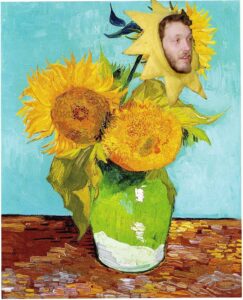Sunflowers swing both ways, yes, but it is perhaps less common to know that, in reality, when they grow densely in a field, they adopt a zigzag pattern with their neighbours, and lean in opposite directions to catch as much light as possible and avoid the shade of fellow plants.
This seemingly simple and obvious strategy could one day give us a way to increase crop yields.
 These flowers have fascinated scientists and artists such as Vincent van Gogh (although he placed them inside a vase), and they are not the only ones that follow the sun’s path across the sky, in a movement known as heliotropism. The flowers of the soya bean, marigold, cotton and various spices of the mallow family also turn during the day to look at the all-illuminating star.
These flowers have fascinated scientists and artists such as Vincent van Gogh (although he placed them inside a vase), and they are not the only ones that follow the sun’s path across the sky, in a movement known as heliotropism. The flowers of the soya bean, marigold, cotton and various spices of the mallow family also turn during the day to look at the all-illuminating star.
If we grow some plants so that they cannot move and orient them improperly in the morning, away from sunrise, their leaves will become 10% smaller than if they can monitor the sun. But is the turning due to an internal clock or to environmental cues? If we create an artificial 30-hour day-night cycle, the sunflowers do not move back and forth on a regular schedule, but if we set a 24-hour cycle the plants begin to follow the sun, suggesting that an internal circadian rhythm is at least partially responsible .
What makes sunflowers different is a behaviour unheard of in the animal kingdom: self-organisation.
.
Instead of leaving winners and losers (something Darwin’s natural selection would say), sunflowers twist their stems to avoid the shadow of their nearest neighbour, according to a study by Antonio Hall, a crop ecophysiologist at the University of Buenos Aires. It would be like what we do when we go to the cinema if a person sits in the opposite armchair who is too tall.
Sunflowers detect the quality of light thanks to a photoreceptor called phytochrome, which allows them to perceive the difference between red and far-red light. When sunlight arrives, the leaf absorbs the red hue and reflects the far-red light, which expands at its periphery. This is the signal that the plants at the edge perceive as a shadow, and which leads them to lean towards the opposite location .
As with other self-organising behaviours among animal species, there is a “pioneer” plant that starts its process: in an early growth stage it “decides” to bend down to look for better light quality, and here it starts a domino effect that can sometimes collide with another row of sunflowers.

As with everything in life, this phenomenon does not occur in all sunflowers: research has focused on a hybrid called“Paradise 20“, developed by the Nidera company, which for 15 years was very successful in cultivation, but with low intensity. This behaviour can increase yields by 25 to 45%.
Other species found in our country are smaller than in South America (where five plants are usually planted per square metre and, in the study, they planted between 10 and 14), and eight to ten units are planted per square metre, so this self-organising behaviour does not have the conditions to develop.
And another curiosity: when the days are gloomy and the sun is not shining, the sunflowers turn in such a way that they seem to look at each other, intending to sharing their energy.
📎 Oliva, J. [Jesús]. (2024, 14 September). The Sunflower Society. PsicoPop. https://www.psicopop.top/en/the-sunflower-society/
📖 References:
